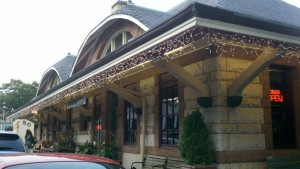Henry Hobson Richardson in Newton
Historical Architecture Buildings in Newton by H. H. Richardson
Henry Hobson Richardson (September 29, 1838 – April 27, 1886) was a prominent American architect who designed buildings in Albany, Boston, Buffalo, Chicago, Pittsburgh, and other cities. The style he popularized is named for him: Richardsonian Romanesque. Along with Louis Sullivan and Frank Lloyd Wright, Richardson is one of “the recognized trinity of American architecture”.
He’s the Frank Lloyd Wright of Newton!




 Interested in learning more about H. H. Richardson? Click on image of any of these books.
Interested in learning more about H. H. Richardson? Click on image of any of these books.
H. H. Richardson also did a fair number of buildings in Newton and many still remain intact! One element that defines Richardson’s style is the use of two colored rough hewn stone. He uses this architectural “vocabulary” in all his buildings yet despite the heaviness and solidity of the stonework, his buildings have grace and lightness from his abundant use of arches. It’s Ancient Egypt Pyramids Meets Roman Arches!
 Trinity Church, Copley Square, Boston. This is NOT in Boston but is considered his finest work. You can see how he developed his architectural “vocabulary” from earlier projects. The two different tones of stone, repeated arches supported by pillars, and surprisingly gracefulness and lightless for a structure built of stone.
Trinity Church, Copley Square, Boston. This is NOT in Boston but is considered his finest work. You can see how he developed his architectural “vocabulary” from earlier projects. The two different tones of stone, repeated arches supported by pillars, and surprisingly gracefulness and lightless for a structure built of stone.
 Baptist Church, Newton Corner, Built 1884
Baptist Church, Newton Corner, Built 1884
Richardson Romanesque
Immanuel Baptist Church
1886
Newton, MA
Marash Girl is concerned that it’s now sprouting trees.
H. H. Richardson designed all the Newton Green Line T stations but only two have survived. The Newton Centre station has recently been converted to a very successful diner.
The Newton Railroad Stations Historic District in Newton, Massachusetts is composed of three geographically separate historic railroad stations on the old Boston and Albany Railroad‘s Riverside or Highland Branch, which is today’s MBTA Green Line “D” Branch. It also includes the baggage and express building next to one of the stations. These four buildings are the only survivors of a dozen or more Newton railroad stations and ancillary buildings built in the 1880s which were designed by noted architect Henry Hobson Richardson in collaboration with famous landscape architect Frederick Law Olmsted. None of the Olmsted landscaping has survived. Wikipedia
The Newton Highlands station is now commercial building space.
First Baptist Church in Newton Centre is not designed by H. H. Richardson, but his style is emulated by John Lyman Faxon.
Listed in the National Register of Historic Places, the building was designed by the young Boston architect John Lyman Faxon (1815-1918) and it was completed in 1888. It was completed in the Late Victorian era, one of the most significant periods of American architecture now recognized as unique and indigenous to the United States. The church has since resisted temptations of succeeding generations to alter the building to more current styles, so it remains a fine, intact, handsome example of uniquely American building.
The building exhibits fine examples of late 19th Century American stained glass, unique in that they were all in place at the completion of the building. Presumably mostly the work of Donald McDonald, a leading Boston studio, they are significant in utilizing then-new opalescent glass and are largely influenced by the work of LaFarge and Tiffany.
Faxon uses the same vernacular as H. H. Richarson — the use of two colored stone, arches, and graceful pillars under the arches. H. H. Richardson would never have juxtaposed the bell tower so awkwardly off the side of the main building though. And the patterns on the front entrance are more Arts and Crafts than Richardsonian Romanesque. Perhaps imitation is a sincere form of flattery but copying never stands the test of time. John Lyman Faxon’s work is only knows as an inferior version of H. H. Richardson. He would have been better off to come up with his own signature style.












Newton Centre was the last station on the Boston & Albany Railroad’s Highland Branch with an open ticket office (on weekdays). It closed at the end of B&A service in May 1958. The next to last open ticket office was Waban. When it closed the ticket agent exercised his seniority and moved to Newton Centre station. This agent was Wilfred Deslauriers who lived in Newton Highlands. He retired in 1958 when Newton Centre station office closed. He had 48 years of service with the Boston & Albany, which in 1900 became a leased property of the New York Central Railroad.